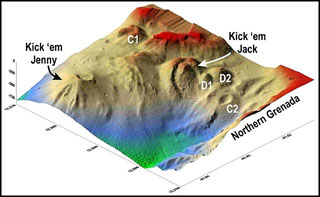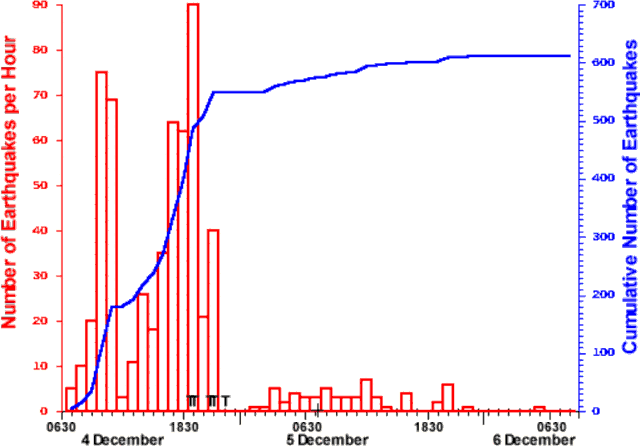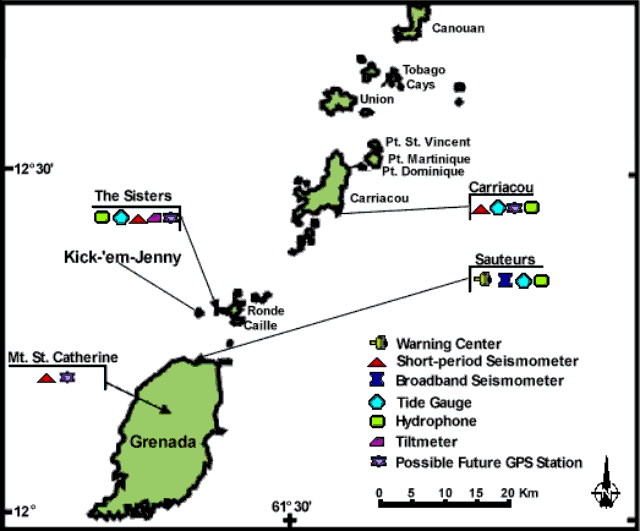Report on Kick 'em Jenny (Grenada) — November 2001
Bulletin of the Global Volcanism Network, vol. 26, no. 11 (November 2001)
Managing Editor: Richard Wunderman.
Kick 'em Jenny (Grenada) Submarine eruptions recorded during December 2001
Please cite this report as:
Global Volcanism Program, 2001. Report on Kick 'em Jenny (Grenada) (Wunderman, R., ed.). Bulletin of the Global Volcanism Network, 26:11. Smithsonian Institution. https://doi.org/10.5479/si.GVP.BGVN200111-360160
Kick 'em Jenny
Grenada
12.3°N, 61.64°W; summit elev. -185 m
All times are local (unless otherwise noted)
Submarine volcanic eruptions occurred at Kick-'em-Jenny during 4-6 December 2001. The last reported activity at the volcano was in March 1990 when strong acoustic T-phase signals were recorded and interpreted to have been associated with a submarine eruption (BGVN 15:03).
The Seismic Research Unit (SRU) of the University of the West Indies reported that the first signs of unrest at Kick-'em-Jenny were observed in October 2001 when a slight increase in seismicity was recorded at stations close to the volcano. Due to the observed increase in seismicity, on 12 September the Alert Level at the volcano was raised from Green ("volcano is quiet") to Yellow ("volcano is restless"). Increased seismicity continued through November, further increasing during 1-2 December when three small earthquakes were recorded.
On 4 December a burst of seismicity began at 0600 and lasted until 1100 (figure 1). During 0600 to 1000 the Mount St. Catherine seismograph in Grenada, ~16 km SSW of the volcano (figures 1 and 2), recorded one event every 4 minutes. By about 1000 the earthquake rate had increased to more than one per minute until 1100. Seismographs at the Sisters station, ~2 km E of the volcano, recorded earthquakes in such rapid succession that activity appeared to be continuous.
Magnitudes of the larger earthquakes increased throughout 4 December; during 0600-0700 the largest earthquake was M 2, during 0800-0900 it was M 2.4, by 1400-1500 it was M 2.7, and the maximum magnitude earthquake recorded that day, M 3, occurred around 1600. Due to the increase in seismicity, at 1830 on 4 December the Alert Level was raised from Yellow to Orange ("Highly elevated level of seismic and/or fumarolic activity or other unusual activity. Eruption may begin with less than 24 hours notice."). This level of alert meant that ships were not permitted to enter either of two concentric exclusion zones; the first zone was 1.5 km in radius around the volcano and the second was 5 km in radius.
The first clear sign of an eruption at Kick-'em-Jenny occurred on 4 December at 1918 when seismometers recorded T-phase signals (acoustic waves generated from an earthquake or underwater explosion that travel through the ocean) (figure 1). The signals lasted about 5 minutes as registered at the Mount St. Catherine station. Another T-phase signal followed at 1926 with a lower amplitude and a shorter duration (3 minutes). Following this eruption the number of discrete earthquakes diminished dramatically; during 1919-2000 there were only eight. Forty five discrete earthquakes preceded the next T-phase signals at 2115. These T-phase signals consisted of a very low-frequency segment followed by a higher-frequency segment that lasted for 6 minutes. A similar event, but with a narrower spectral signature, occurred at 2123.
About an hour later, at 2231, the largest T-wave signal during the December episode was recorded at the Mount St. Catherine station, lasting until 2312. T-phase signals were also recorded at the station in Trinidad about 175 km to the S. While this was the largest eruption recorded during the December episode, it was small in comparison to those of March 1990 (BGVN 15:03). Following the 2231 eruption the number of discrete earthquakes was very low, and by 5 December at 0700 only 19 earthquakes occurred.
By 6 December seismicity at Kick-'em-Jenny consisted of only occasional small earthquakes. The SRU confirmed that no signs of volcanic activity were visible on the sea surface. By this time, activity seemed to have stopped, but SRU scientists maintained the Orange Alert level for another 24 hours as a precaution.
In retrospect, the premonitory earthquake swarms were more severe than any previously recorded at Kick-'em-Jenny, but the size of the eruption as interpreted from the intensity of the T-phase signals was very low. SRU's updates stated that on 6 December as of 1115, many small pleasure craft that were observed traveling directly over Kick-'em-Jenny would be in danger if a larger eruption were to occur.
The SRU determined that what was initially thought to be a fairly strong local earthquake (Mt 2.7) on 6 December at 2208 was actually the culmination of a minor swarm of 10-15 microearthquakes directly beneath the volcano. At this point the Alert Level remained at Orange because scientists believed that the eruptions on 4 December probably deposited a layer of hot rock around the summit that would continue to release heat for a long period of time. This hot water would cause the area near the volcano to be turbulent and pose a threat to ships in the vicinity. The Orange Alert Level was further extended after careful scrutiny of seismograph records on 7 December showed that a short T-phase signal was generated from Kick-'em-Jenny on 6 December at 1829. The signal was interpreted to represent a minor eruption, therefore, the Alert Level was extended until 8 December at 1000.
Following the 6 December seismicity, there was no further volcanic or seismic activity at Kick-'em-Jenny. After consultation with the government of Grenada, on 8 December at 1000 the SRU reduced the Alert Level at the volcano from Orange to Yellow. The change in Alert Level included a reduction in boating restrictions to only include the first exclusion zone (1.5 km radius from the volcano).
Geological Summary. Kick 'em Jenny, an active submarine volcano 8 km off the N shore of Grenada, rises 1,300 m from the sea floor. Recent bathymetric surveys have shown evidence for a major arcuate collapse structure, which was the source of a submarine debris avalanche that traveled more than 15 km W. Bathymetry also revealed another submarine cone to the SE, Kick 'em Jack, and submarine lava domes to its S. These and subaerial tuff rings and lava flows at Ile de Caille and other nearby islands may represent a single large volcanic complex. Numerous eruptions have occurred since 1939, mostly documented by acoustic signals. Prior to the 1939 eruption, when an eruption cloud rose 275 m above the ocean and was witnessed by a large number of people in northern Grenada, there had been no written mention of the volcano. Eruptions have involved both explosive activity and the quiet extrusion of lava flows and lava domes in the summit crater; deep rumbling noises have sometimes been heard onshore. Recent eruptions have modified the morphology of the summit crater.
Information Contacts: John Shepard, Richie Robertson, Jan Lindsay, and Joan Latchman, Seismic Research Unit of the University of the West Indies, St. Augustine, Trinidad, W.I. (URL: http://www.uwiseismic.com/).



